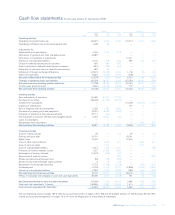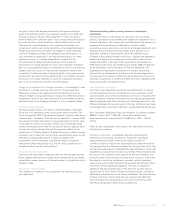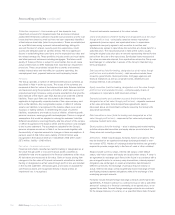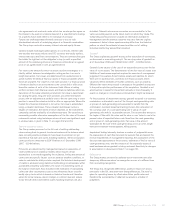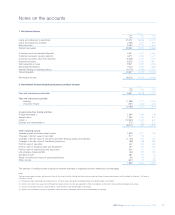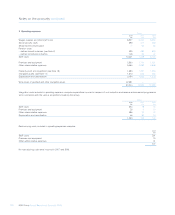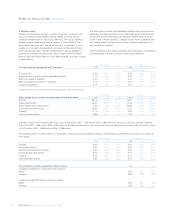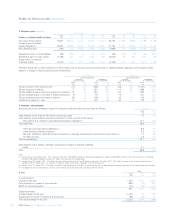RBS 2008 Annual Report Download - page 185
Download and view the complete annual report
Please find page 185 of the 2008 RBS annual report below. You can navigate through the pages in the report by either clicking on the pages listed below, or by using the keyword search tool below to find specific information within the annual report.
Accounting policies continued
RBS Group Annual Report and Accounts 2008184
18. Loan commitments
Provision is made for loan commitments, other than those classified as
held-for-trading, if it is probable that the facility will be drawn and the
resulting loan will be recognised at a value less than the cash
advanced. Syndicated loan commitments in excess of the level of
lending under the commitment approved for retention by the Group are
classified as held-for-trading and measured at fair value.
19. Derecognition
A financial asset is derecognised when it has been transferred and the
transfer qualifies for derecognition. A transfer requires that the Group
either: (a) transfers the contractual rights to receive the asset’s cash
flows; or (b) retains the right to the asset’s cash flows but assumes a
contractual obligation to pay those cash flows to a third party. After a
transfer, the Group assesses the extent to which it has retained the risks
and rewards of ownership of the transferred asset. If substantially all
the risks and rewards have been retained, the asset remains on the
balance sheet. If substantially all the risks and rewards have been
transferred, the asset is derecognised. If substantially all the risks and
rewards have been neither retained nor transferred, the Group assesses
whether or not it has retained control of the asset. If it has not retained
control, the asset is derecognised. Where the Group has retained
control of the asset, it continues to recognise the asset to the extent of
its continuing involvement.
A financial liability is removed from the balance sheet when the
obligation is discharged, or cancelled, or expires.
20. Sale and repurchase transactions
Securities subject to a sale and repurchase agreement under which
substantially all the risks and rewards of ownership are retained by the
Group continue to be shown on the balance sheet and the sale
proceeds recorded as a deposit. Securities acquired in a reverse sale
and repurchase transaction under which the Group is not exposed to
substantially all the risks and rewards of ownership are not recognised
on the balance sheet and the consideration is recorded in Loans and
advances to banks or Loans and advances to customers as
appropriate.
Securities borrowing and lending transactions are usually secured by
cash or securities advanced by the borrower. Borrowed securities are
not recognised on the balance sheet or lent securities derecognised.
Cash collateral received or given is treated as a loan or deposit;
collateral in the form of securities is not recognised. However, where
securities borrowed are transferred to third parties, a liability for the
obligation to return the securities to the stock lending counterparty is
recorded.
21. Netting
Financial assets and financial liabilities are offset and the net amount
presented in the balance sheet when, and only when, the Group
currently has a legally enforceable right to set off the recognised
amounts; and it intends either to settle on a net basis, or to realise the
asset and settle the liability simultaneously. The Group is party to a
number of arrangements, including master netting agreements, that
give it the right to offset financial assets and financial liabilities but
where it does not intend to settle the amounts net or simultaneously and
therefore the assets and liabilities concerned are presented gross.
22. Capital instruments
The Group classifies a financial instrument that it issues as a financial
asset, financial liability or an equity instrument in accordance with the
substance of the contractual arrangement. An instrument is classified
as a liability if it is a contractual obligation to deliver cash or another
financial asset, or to exchange financial assets or financial liabilities on
potentially unfavourable terms. An instrument is classified as equity if it
evidences a residual interest in the assets of the Group after the
deduction of liabilities. The components of a compound financial
instrument issued by the Group are classified and accounted for
separately as financial assets, financial liabilities or equity as
appropriate.
23. Derivatives and hedging
Derivative financial instruments are initially recognised, and
subsequently measured, at fair value. Derivative fair values are
determined from quoted prices in active markets where available.
Where there is no active market for an instrument, fair value is derived
from prices for the derivative’s components using appropriate pricing or
valuation models.
A derivative embedded in a contract is accounted for as a stand-alone
derivative if its economic characteristics are not closely related to the
economic characteristics of the host contract; unless the entire contract
is carried at fair value through profit or loss.
Gains and losses arising from changes in the fair value of a derivative
are recognised as they arise in profit or loss unless the derivative is the
hedging instrument in a qualifying hedge. The Group enters into three
types of hedge relationship: hedges of changes in the fair value of a
recognised asset or liability or firm commitment (fair value hedges);
hedges of the variability in cash flows from a recognised asset or
liability or a forecast transaction (cash flow hedges); and hedges of the
net investment in a foreign operation.
Hedge relationships are formally documented at inception. The
documentation includes identification of the hedged item and the
hedging instrument, details the risk that is being hedged and the way in
which effectiveness will be assessed at inception and during the period
of the hedge. If the hedge is not highly effective in offsetting changes in
fair values or cash flows attributable to the hedged risk, consistent with
the documented risk management strategy, hedge accounting is
discontinued.
Fair value hedge – in a fair value hedge, the gain or loss on the
hedging instrument is recognised in profit or loss. The gain or loss on
the hedged item attributable to the hedged risk is recognised in profit or
loss and adjusts the carrying amount of the hedged item. Hedge
accounting is discontinued if the hedge no longer meets the criteria for
hedge accounting or if the hedging instrument expires or is sold,
terminated or exercised or if hedge designation is revoked. If the
hedged item is one for which the effective interest rate method is used,
any cumulative adjustment is amortised to profit or loss over the life of
the hedged item using a recalculated effective interest rate.
Cash flow hedge – where a derivative financial instrument is designated
as a hedge of the variability in cash flows of a recognised asset or
liability or a highly probable forecast transaction, the effective portion of





